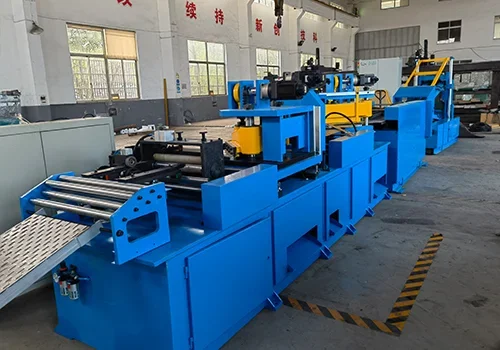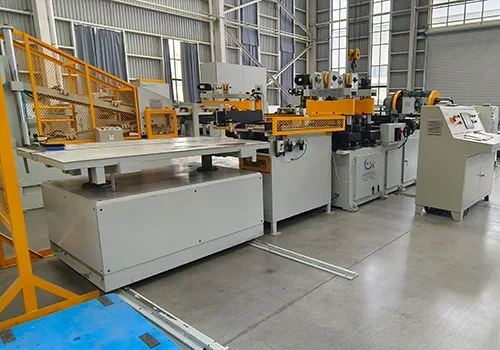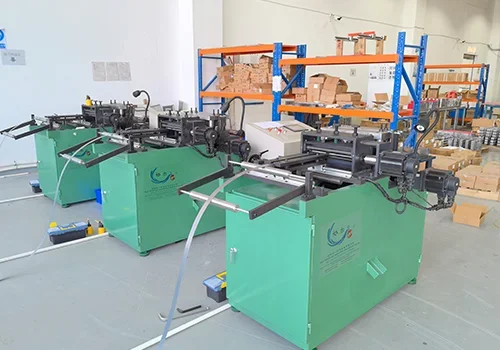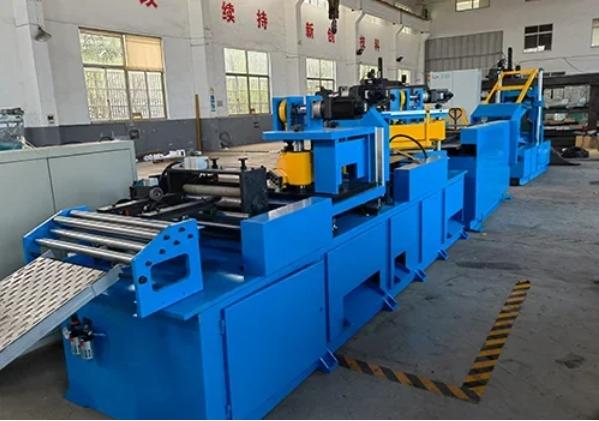Silicon steel is a specialized type of steel alloyed with silicon to enhance its magnetic properties, making it essential for electrical applications, particularly in transformers, motors, and generators. The efficient processing of silicon steel into precise shapes and sizes is crucial for the performance and reliability of these electrical components. Silicon steel cutting machines play a vital role in this process, offering accuracy, speed, and minimal material waste. This blog post explores the purpose and functionality of silicon steel cutting machines, highlighting their importance in modern manufacturing and spotlighting companies Ruyi Transformer Equipments Manufacturer Co., Ltd.
What is Silicon Steel and Why is it Important?
Silicon steel, also known as electrical steel or transformer steel, is a ferromagnetic alloy containing silicon (typically 0.5% to 4.5% by weight). The addition of silicon improves the steel's magnetic softness and increases its electrical resistivity. These properties are crucial for reducing energy losses due to hysteresis and eddy currents when the steel is subjected to alternating magnetic fields.
Key properties of silicon steel include:
High Permeability: Allows the steel to easily conduct magnetic flux.
Low Coercivity: Reduces energy losses during magnetization and demagnetization cycles.
High Electrical Resistivity: Minimizes eddy current losses, which generate heat and reduce efficiency.
Silicon steel is primarily used in the cores of transformers, stators and rotors of electric motors, and generators. Its ability to efficiently channel magnetic fields makes it indispensable for these applications, contributing to the overall efficiency and performance of electrical systems.
The Purpose of Silicon Steel Cutting Machines
Silicon steel is typically manufactured in thin laminations to further reduce eddy current losses. These laminations need to be cut into precise shapes and sizes to form the cores of transformers and other electrical components. Silicon steel cutting machines are designed specifically for this purpose, offering several advantages over traditional cutting methods:
Precision: Silicon steel cutting machines can achieve tight tolerances, ensuring accurate dimensions and consistent performance of the finished components.
Speed: High-speed cutting machines can process large volumes of silicon steel quickly, increasing manufacturing throughput.
Minimal Burr Formation: The cutting process minimizes burr formation, which is essential for ensuring proper stacking and contact between laminations.
Material Optimization: Advanced cutting machines can optimize material utilization, reducing waste and minimizing production costs.
Types of Silicon Steel Cutting Machines
Several types of silicon steel cutting machines are available, each offering unique capabilities and features:
Slitting Lines: These machines cut wide coils of silicon steel into narrow strips, which are then used to produce transformer cores and other components.
Cut-to-Length Lines: These machines cut silicon steel strips into specific lengths, often incorporating bevel cutting and V-shape notching capabilities.
Rectangular Cutting Machines: These machines cut silicon steel coils into rectangular laminations for transformers, welders, and reactors.
Laser Cutting Machines: Laser cutting offers high precision and flexibility for creating complex shapes in silicon steel laminations.

Functionality and Components
A typical silicon steel cutting machine consists of several key components:
Decoiler: Holds and unwinds the coil of silicon steel.
Feeding System: Precisely feeds the silicon steel strip into the cutting area. Servo motors are often used for accurate and repeatable positioning.
Cutting Unit: Performs the actual cutting operation, using various methods such as shearing, punching, or laser cutting.
Control System: Controls and monitors the entire cutting process, ensuring accuracy and efficiency. PLC (Programmable Logic Controller) and HMI (Human Machine Interface) systems are commonly used.
Stacking or Collection System: Collects and stacks the cut laminations for further processing.
Advantages of Laser Cutting for Silicon Steel
Laser cutting has emerged as a preferred method for cutting silicon steel due to its numerous advantages:
High Precision: Laser cutting can achieve extremely precise cuts, down to the micron level, ensuring accurate dimensions and consistent performance.
Minimal Burr Formation: The laser cutting process minimizes burr formation, which is crucial for ensuring proper stacking and contact between laminations.
Complex Geometries: Laser cutting can create intricate shapes and fine details that are challenging or impossible to achieve with traditional methods.
Material Versatility: Laser cutting can process various types of silicon steel, regardless of their thickness or composition.
Reduced Material Waste: Laser cutting optimizes material utilization, reducing waste and minimizing production costs.
Non-Contact Process: Laser cutting is a non-contact process, which eliminates the risk of mechanical damage to the silicon steel.
Ruyi: A Leader in Silicon Steel Cutting Solutions
Ruyi Transformer Equipments Manufacturer Co., Ltd. is a company specializing in the design, manufacturing, and supply of silicon steel cutting machines for the transformer and electrical industries. With a focus on innovation, quality, and customer satisfaction, Ruyi Transformer Equipments is committed to providing advanced solutions that meet the evolving needs of its clients.
Comprehensive Product Range: Ruyi Transformer Equipments offers a wide range of silicon steel cutting machines, including slitting lines, cut-to-length lines, and rectangular cutting machines.
Customization and Expertise: Ruyi Transformer Equipments provides customized solutions tailored to the specific requirements of its customers. Their team of experienced engineers works closely with clients to develop optimized cutting solutions for various applications.
Advanced Technology: Ruyi Transformer Equipments utilizes state-of-the-art equipment and technology to ensure the highest levels of precision, efficiency, and reliability.
Quality Assurance: Ruyi Transformer Equipments adheres to strict quality control procedures to ensure that all products meet or exceed industry standards.

Applications of Ruyi Transformer Equipments Cutting Machines
Ruyi Transformer Equipments cutting machines are used in a wide range of applications, including:
Transformer Core Manufacturing: Cutting silicon steel laminations for transformer cores of various sizes and shapes.
Electric Motor and Generator Production: Preparing silicon steel laminations for stators and rotors in electric motors and generators.
Welding Machine Core Manufacturing: Producing silicon steel strips and laminations for welding machine cores.
Reactor Core Production: Cutting silicon steel components for reactor cores used in power systems.
Factors to Consider When Choosing a Silicon Steel Cutting Machine
When selecting a silicon steel cutting machine, several factors should be considered:
Cutting Requirements: Determine the specific cutting requirements, including the type of silicon steel, the desired shapes and sizes, and the required precision and throughput.
Cutting Method: Choose the appropriate cutting method based on the cutting requirements, considering factors such as speed, accuracy, burr formation, and material waste.
Machine Capacity: Select a machine with sufficient capacity to handle the required volume of silicon steel.
Automation Level: Consider the level of automation required, balancing the need for efficiency with the cost of automation.
Budget: Determine the budget for the machine, considering both the initial investment and the ongoing operating costs.
Supplier Reputation: Choose a reputable supplier with a proven track record of providing high-quality machines and reliable support.
The Future of Silicon Steel Cutting Technology
As technology continues to advance, silicon steel cutting machines are expected to become even more efficient, precise, and versatile. Future trends in silicon steel cutting technology include:
Improved Laser Cutting Technology: Development of more powerful and efficient lasers that can cut silicon steel faster and with greater precision.
Advanced Control Systems: Integration of artificial intelligence (AI) and machine learning (ML) to optimize cutting parameters and improve machine performance.
Automation and Robotics: Increased use of automation and robotics to streamline the cutting process and reduce labor costs.
Integration with Industry 4.0: Seamless integration of silicon steel cutting machines with other manufacturing systems for real-time monitoring, data analysis, and predictive maintenance.

Conclusion
Silicon steel cutting machines are essential for the efficient and precise processing of silicon steel into components for transformers, motors, generators, and other electrical equipment. With their ability to deliver accuracy, speed, and minimal material waste, these machines play a crucial role in modern manufacturing. Companies Ruyi Transformer Equipments Manufacturer Co., Ltd. are at the forefront of this technology, providing innovative solutions that empower manufacturers to meet the challenges of today and tomorrow. As technology continues to evolve, silicon steel cutting machines will undoubtedly play an increasingly critical role in shaping the future of the electrical industry.
Understanding the Functions of Silicon Steel Cutting Machines in Electrical Engineering

